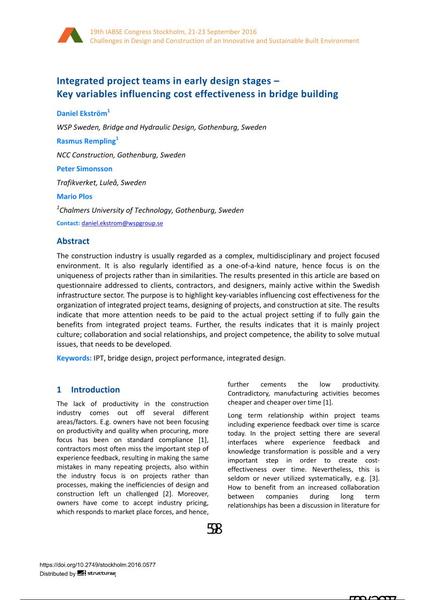Integrated project teams in early design stages – Key variables influencing cost effectiveness in bridge building

|
|
|||||||||||
Détails bibliographiques
| Auteur(s): |
Daniel Ekström
(WSP Sweden, Bridge and Hydraulic Design, Gothenburg, Sweden)
Rasmus Rempling Peter Simonsson (Trafikverket, Luleå, Sweden ) Mario Plos (Chalmers University of Technology, Gothenburg, Sweden) |
||||
|---|---|---|---|---|---|
| Médium: | papier de conférence | ||||
| Langue(s): | anglais | ||||
| Conférence: | IABSE Congress: Challenges in Design and Construction of an Innovative and Sustainable Built Environment, Stockholm, Sweden, 21-23 September 2016 | ||||
| Publié dans: | IABSE Congress Stockholm, 2016 | ||||
|
|||||
| Page(s): | 598-606 | ||||
| Nombre total de pages (du PDF): | 9 | ||||
| Année: | 2016 | ||||
| DOI: | 10.2749/stockholm.2016.0577 | ||||
| Abstrait: |
The construction industry is usually regarded as a complex, multidisciplinary and project focused environment. It is also regularly identified as a one-of-a-kind nature, hence focus is on the uniqueness of projects rather than in similarities. The results presented in this article are based on questionnaire addressed to clients, contractors, and designers, mainly active within the Swedish infrastructure sector. The purpose is to highlight key-variables influencing cost effectiveness for the organization of integrated project teams, designing of projects, and construction at site. The results indicate that more attention needs to be paid to the actual project setting if to fully gain the benefits from integrated project teams. Further, the results indicates that it is mainly project culture; collaboration and social relationships, and project competence, the ability to solve mutual issues, that needs to be developed. |
||||
